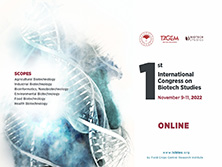Biotech Studies
2008, Vol 17, Num, 1-2
The Effects of Nitrogen Application Times on Phenological Stages, Yield and Yield Components of Bread Wheat (Triticum aestivum L.) in Kahramanmaraş Conditions
2 Kahramanmaraş Tarımsal Araştırma Enstitüsü, Kahramanmaraş
3 Kahramanmaraş Tarım İl Müdürlüğü, Kahramanmaraş
4 Kahramanmaraş Sütçü İmam Üniversitesi Ziraat Fakültesi Tarla Bitkileri Bölümü, Kahramanmaraş - This research was carried out to determine the effects of nitrogen application times on phenological stages, yield and yield components of three bread wheat varieties (Triticum aestivum L.) in 2000-2001 and 2001-2002 crop years in Kahramanmaraş conditions. Experimental design was split plot arrangement on randomized complete block design with 4 replications. In the experiment bread wheat varieties (Seri-82, Balatilla and Golia) were main plots, 6 nitrogen application times were sup-plots. The amount of 24 kg/da nitrogen was applied at 6 different combinations of growing periods based on sowing time (Zadoks, 00), tillering with 3-4 tillers (Zadoks, 23-24), beginning of the stem elongation (Zadoks, 31) and booting (Zadoks, 45). Vegetative period (VP), grain filling period (GFP), days to maturity (DM), head number m–2 (HN/m2), grain number per head (GN/H), grain weight per head (GW/H), biomass (B), harvest index (HI) and grain yield (GY) were investigated. The effects of nitrogen application times were only significant for HI and GY in the first year, for GN/H, in the second year, and non-significant for the other traits in both years. It was determined that sowing time and beginning of the stem elongation had more crucial importance for GY, and application times including both of these 2 stages provided more GY. Keywords : Bread wheat, nitrogen application times, yield and yield components, phenological stages















